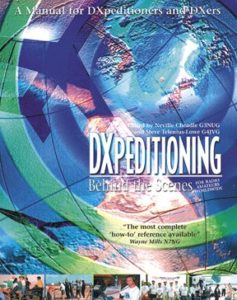Most radio hams dream at one time or another, of packing up some gear and travelling to a remote part of the globe and becoming the DX call.
Being able to take off on your own with everything you need in a couple of suitcases for three or four days is at the light end of the spectrum. Packing a 20-foot container with equipment, being part of a large team and shipping that container to a remote island, is quite another.
The authors of DXpeditioning Behind the Scenes have tended to do the latter.
This book is the bible for planning an expedition, whether it is just you alone, or as part of a team.
The late Neville Cheadle (G3NUG) and Steve Telenius-Lowe (G4JVG) edited the book following their successful expedition to the Spratly Islands as 9M0C in February 1998. Several notable experienced DXpeditioner’s contributed chapters.

Planning a DXpedition takes time and needs a project plan. Chapter two of this book is exactly where the planning starts. Depending on the size of your team, consider how many bands and modes you expect to operate. Will you be on-air 24 hours a day, or as a single operator, concentrate on just one band and mode?
The authors make the point, that once the plan is in place, that to double the size of the operation doesn’t double the planning effort.
Where to travel to is an essential part of the plan. Will you look at a very rare and expensive to travel to spot, or somewhere not needs so much, but an easier target. The most wanted list of countries for those at home to contact will vary across the world. What may be a rare island in Europe, may not be wanted so much in North America. Chapter two gives advice on how to choose.
The authors explain the importance of project plans for the team. Whether this during the preparation stage or on arrival at your destination.
Antenna projects are an example shown on page 11, which lists 12 separate antenna projects, what is required and the order of events.
The equipment chapter written by Don Beattie (G3BJ ex G3OZF) starts with the words, “There’s no going back”. When you are on your paradise island in the Pacific Ocean, you won’t find a handy store to buy the coax you forgot to pack. Don explores the choice of RF equipment and the need for quality and reliability. Depending on the requirements of each station, the diagram on page 57 will remind you of each piece of equipment and the connections required. Don’t leave that vital cable at home!
Planning the equipment, aerials, computers, and travel arrangements are some of the obvious tasks ahead of leaving home. The book reminds us that on arrival, will the location be suitable? Will there be room for each beam or vertical in the antenna field? Just as importantly, is the furniture suitable and large enough for your equipment? Is there enough power, or will you need to take your own generator? This chapter examines ‘The Little Things’ to remember, down to making sure that the headphones you take along, have the right plug to fit the rig.
Chapter nine takes a close look at logistics. Here, questions such as are the carrying cases you have large enough for the equipment and accessories. The suggestion is that all of the equipment from everyone contributing is brought to a single location for checking and packing. Needless to say, all items will have been checked and tested as working long before they are packed into a box for transportation.
Shipping costs are considered and the list on page 67 may show something you have forgotten, or not considered was necessary. For instance, have you considered that there may be a temporary import duty if you didn’t complete the Carnet correctly?
In chapter 10, Tony Canning (G0OPB) looks in detail at RF matters. If you have several stations on different bands at the same time, then what filtering might you need? An examination f the feeder needs and the correct termination is going to make your life much easier.
John Linford (G3WVG) talks about technology in chapter 11. Although this book was produced in 2000 and technology has moved on since then, most o the points made here are equally valid today. For instance, the logging software you use may have a limit on the number of QSOs you can log. It would be a pity on a big expedition to stop at contact number 99,999 because the software can manage six figures.
The book has a chapter on propagation and ways to plan when to be on-air and when to sleep. Different bands will have different needs and making your operator schedule fit around openings while leaving time for eating and sleeping is important for team members.
Dxpeditions cost money. Some, lots of money. The book covers finance, sponsorship and managing costs in some detail. You may be fortunate and find an equipment manufacturer who will donate or lend you equipment, but that isn’t going to pay for accommodation and food at the destination. The finance chapter also covers ways to make money form magazine articles, videos, and QSL cards.
When the DXpedition is over, there is still plenty to do. The chapter titled After the Event runs through several ways to showcase the expedition through talks, presentations and saying thank you to the various sponsors gathered along the way.
Phil Whitchurch (G3SWH) covers the art of the QSL card in chapter 19. Since this was written, the way QSL cards are managed has changed out of all recognition. However, there are still some solid points made, for instance, on how to deal with busted calls in the log.
Chapter 20 tells the Spratly Islands DXpedition Story of 9M0C and is a good read. No spoilers here – just enjoy!
The in the appendix of the book, there is a detailed list of the items packed and taken to Spratly. Discovering how many rolls of self-amalg tape were taken, show the level of detail to consider when planning your own expedition.
This book may be some twenty years old now, but without doubt, is the go-to reference work for anyone planning an expedition for the first time. Even if you have been on trips before, the words of wisdom here can be a reminder for your next expedition.
DXpeditioning Behind the Scenes runs to just over 200 pages and is a paperback format. This book was written in 2000, so is some years old now and finding a new copy may be tricky. Although Nevada Radio in the UK is known to have stock and will ship worldwide. Click here for the book.
The 9M0C team who wrote this book and travelled to Spratly also travelled to the Comoros Islands (D68C), Rodrigues Island (3B9C), and St. Brandon (3B7C).
As the author of this review, I was privileged to be a member of the trips to D68C and 3B9C and found this book of great value. It also inspired me to be a part of a smaller team who went to American Samoa activating two islands as K8O and K8T and when I lived in the South Cook Islands under my own call, E51SC.
This book will inspire you to pick up an atlas, turn some pages and decide where to go in the world.
Just remember to check how many reels of self-amalg tape to pack before you leave!
Bon voyage and gud DX.
